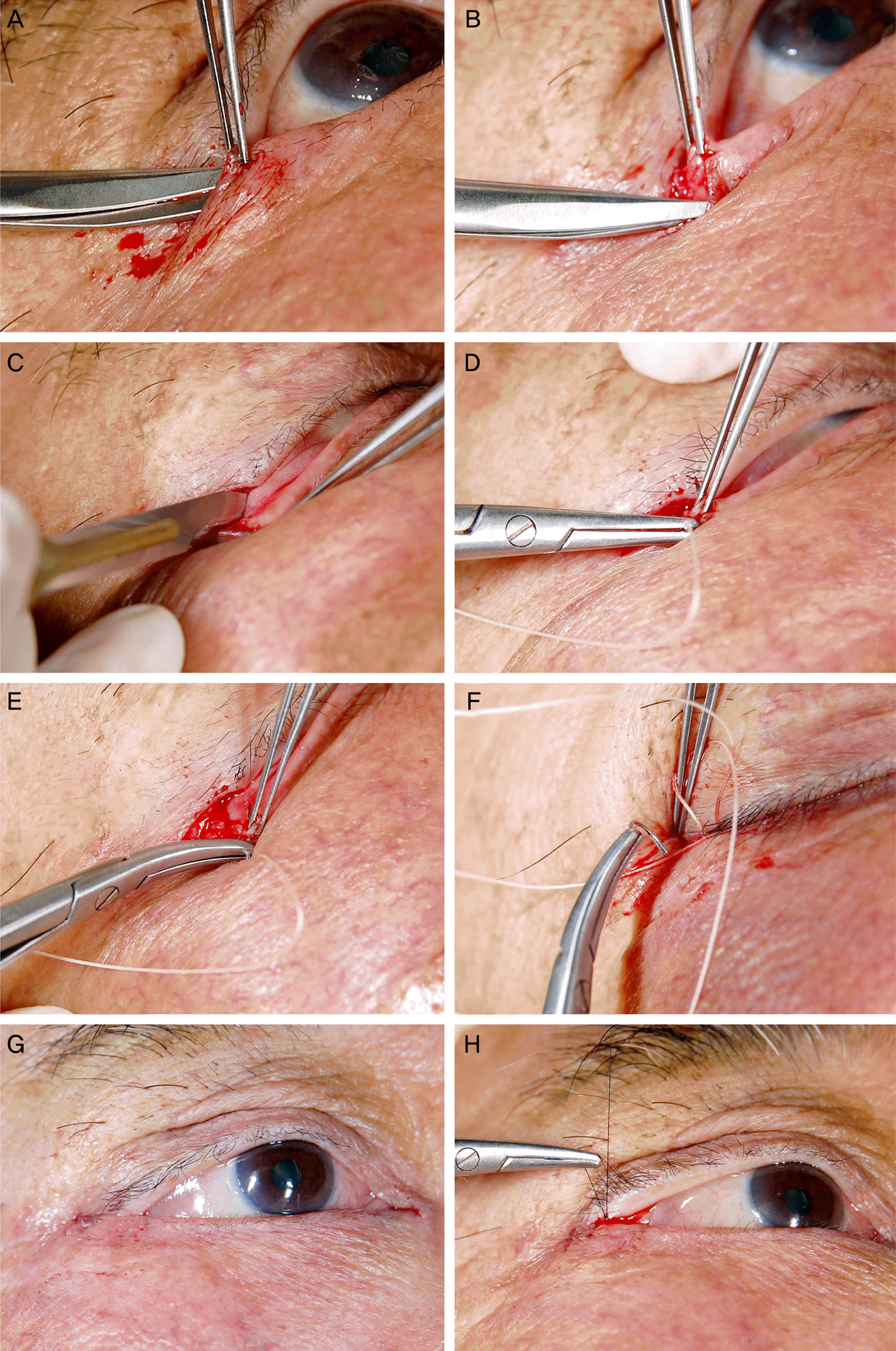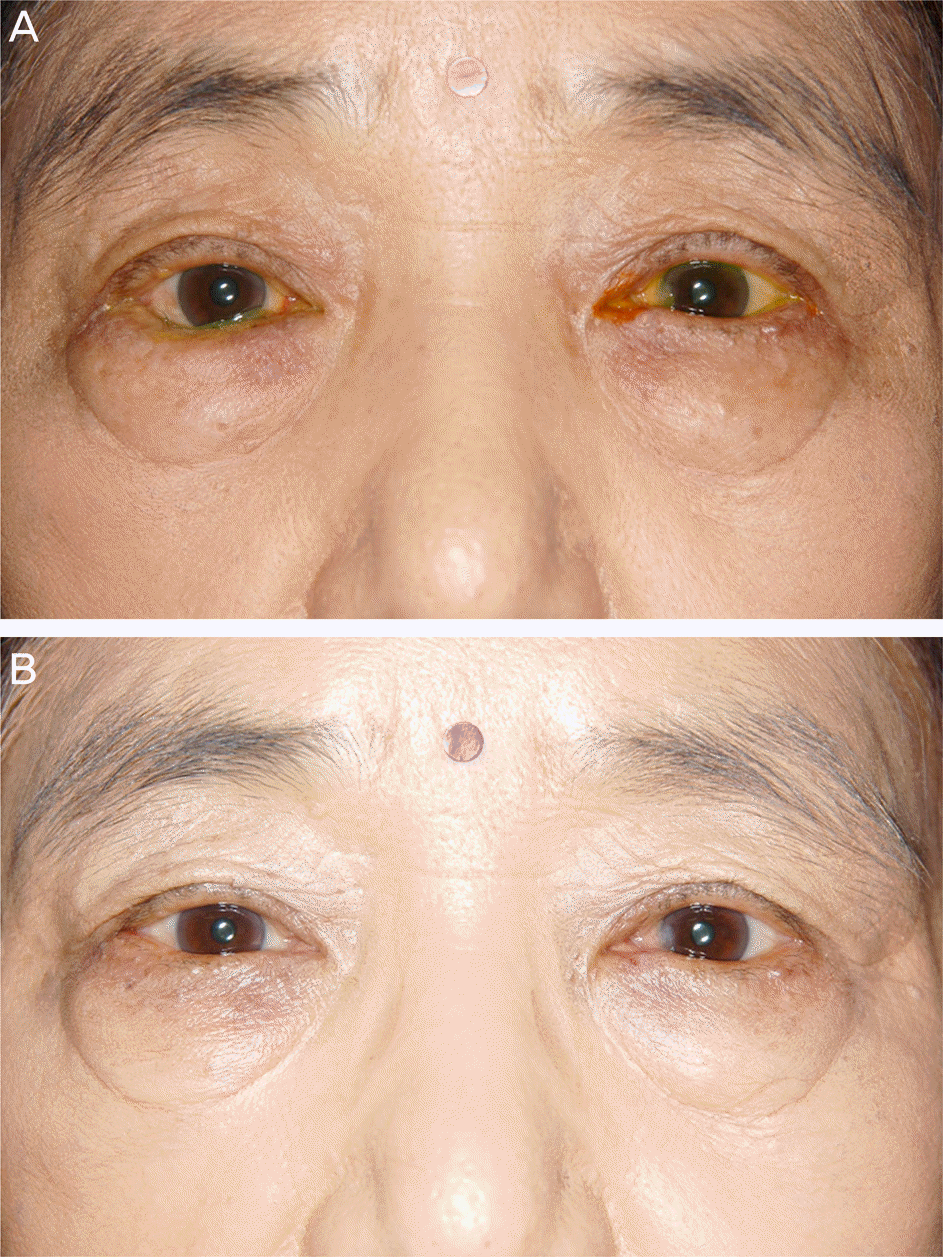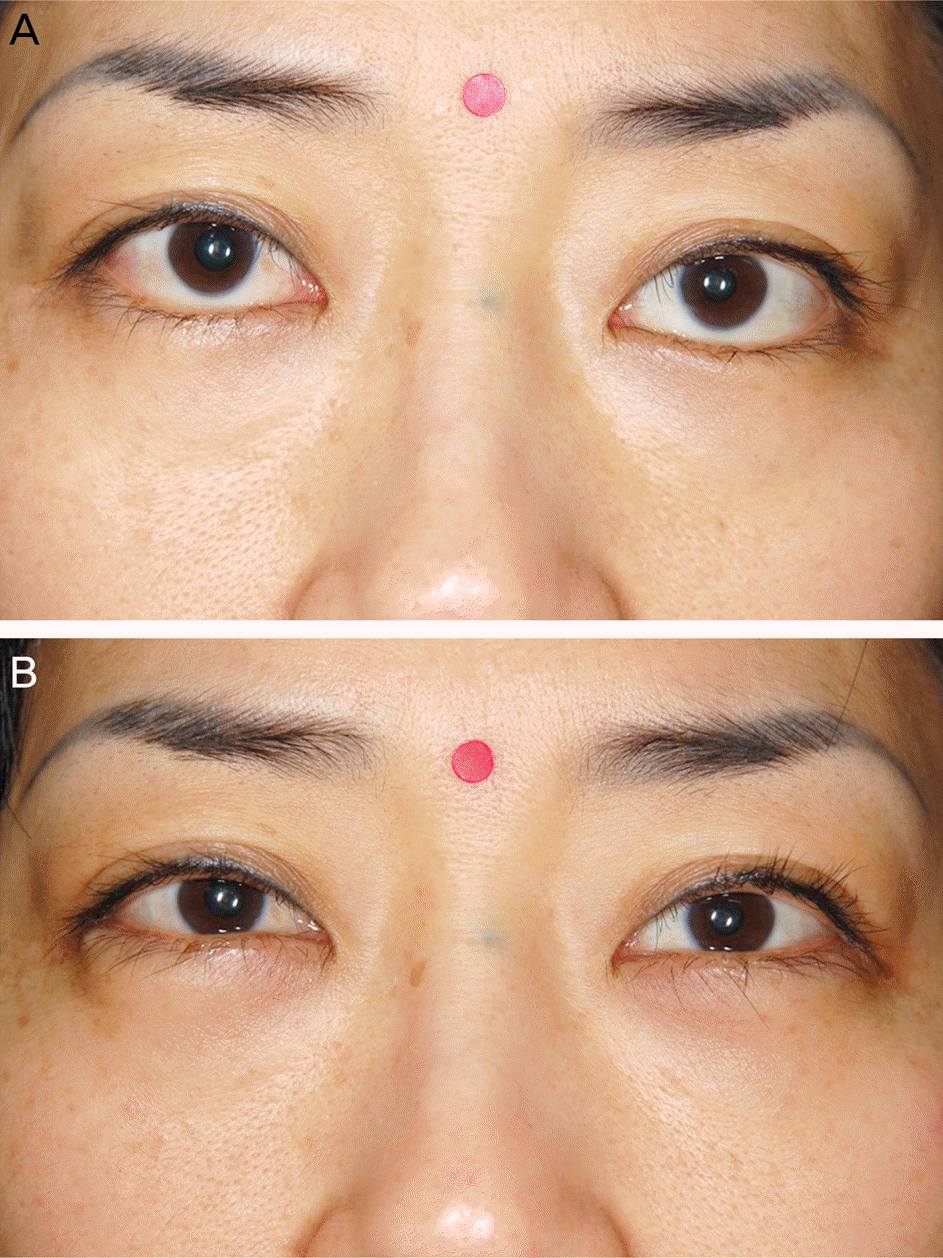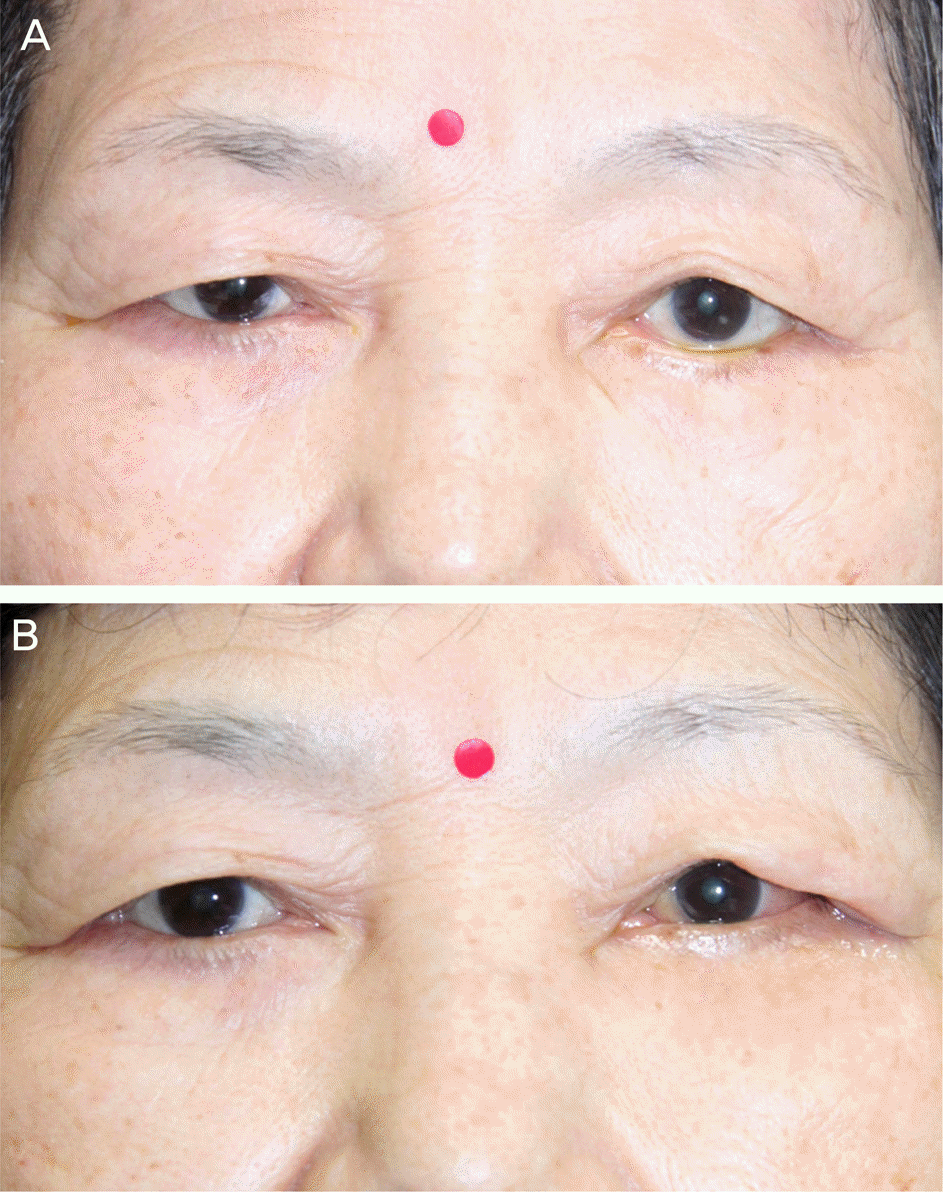Abstract
Methods
The medical records of patients who underwent the lateral tarsal strip procedure between September 2008 and February 2014 were retrospectively reviewed. We examined age, gender, diagnosis, procedures simultaneously performed with the lateral tarsal strip, duration of observation, postoperative complications and cases requiring revision surgery. Patients without recurrence or undercorrection of eyelid/lateral canthal area lesions, surgical complication and not requiring revision surgery until final visit were considered as successful cases.
Results
One hundred eighty-three eyes of 129 patients were included in this study. The mean patient age was 61.6 years and average follow-up duration was 9.2 months. Diagnoses of eyes were lower lid laxity (39.9%), involutional entropion (24.0%), lower lid retraction (14.8%), cicatricial ectropion (6.6%), lateral canthal deformity (5.5%), involutional ectropion (3.8%) and paralytic ectropion (2.7%). Surgical procedures simultaneously conducted with lateral tarsal strip in 167 eyes of 183 eyes were endoscopic dacryocystorhinostomy (30.5%), lower retractor tightening (19.2%), medial spindle procedure (13.8%), mid-lamellar lengthening (12.6%), lower blepharoplasty (10.8%), Quickert suture (4.2%) and Hotz’s operation (3.0%). Successful results were obtained in 116 of 129 patients (89.9%).
Go to : 
References
1. Anderson RL. Tarsal strip procedure for correction of eyelid laxity and canthal malposition in the anophthalmic socket. Ophthalmology. 1981; 88:895–903.

3. Jordan DR, Anderson RL. The lateral tarsal strip revisited. The enhanced tarsal strip. Arch Ophthalmol. 1989; 107:604–6.
4. Lee H, Hwang JY, Kim JW, et al. The effectiveness of simultaneous lateral tarsal strip with endonasal dacryocystorhinostomy for the treatment of nasolacrimal duct obstruction and lower lid laxity. J Craniofac Surg. 2013; 24:980–3.

5. Lee H, Lee JS, Chang M, et al. The effectiveness of simultaneous medial spindle and/or lateral tarsal strip procedure in East Asian patients who need endonasal dacryocystorhinostomy. Graefes Arch Clin Exp Ophthalmol. 2013; 251:2789–96.

6. Kam KY, Cole CJ, Bunce C, et al. The lateral tarsal strip in ectropion surgery: is it effective when performed in isolation? Eye (Lond). 2012; 26:827–32.

7. Ahn TK, Chung WS. Clinical experience of tarsal strip procedure. J Korean Ophthalmol Soc. 1990; 31:1489–94.
8. Kim SW, Lee WS, Rho JH. Lateral tarsal strip procedure combined with quickert sutures in correcting involutional entropion. J Korean Ophthalmol Soc. 2012; 53:1213–8.

9. Kim KH, Chung IY, Seo SW. The effect of augmented lateral tarsal strip for paralytic ectropion in leprosy patients. J Korean Ophthalmol Soc. 2009; 50:497–504.

10. Woo JM, Shin DM, Park JM, Ahn HB. The effects of lateral tarsal strip procedure on the functional nasolacrimal duct obstruction. J Korean Ophthalmol Soc. 2006; 47:1375–80.
11. Ko SJ, Kim SD. Involutional ectropion repair with the modified medial spindle and the lateral tarsal strip procedure. J Korean Ophthalmol Soc. 2012; 53:187–92.

12. Ryu WY, Suh JY, Ahn HB. Lateral tarsal strip procedure and silicone tube intubation on the functional nasolacrimal duct obstruction. J Korean Ophthalmol Soc. 2010; 51:1174–8.

13. Bergeron CM, Moe KS. The evaluation and treatment of lower eyelid paralysis. Facial Plast Surg. 2008; 24:231–41.

15. Ousterhout DK, Weil RB. The role of the lateral canthal tendon in lower eyelid laxity. Plast Reconstr Surg. 1982; 69:620–3.

16. Anderson RL, Hatt MU, Dixon R. Medial ectropion. A new technique. Arch Ophthalmol. 1979; 97:521–4.
17. Stefanyszyn MA, Hidayat AA, Flanagan JC. The histopathology of involutional ectropion. Ophthalmology. 1985; 92:120–7.

20. Corin S, Veloudios A, Harvey JT. A modification of the lateral tarsal strip procedure with resection of orbicularis muscle for entropion repair. Ophthalmic Surg. 1991; 22:606–8.

21. Tenzel RR, Buffam FV, Miller GR. The use of "lateral canthal sling" in ectropion repair. Can J Ophthalmol. 1977; 12:199–202.
22. Liu D. Lower eyelid tightening: a comparative study. Ophthal Plast Reconstr Surg. 1997; 13:199–203.
24. Glat PM, Jelks GW, Jelks EB, et al. Evolution of the lateral canthoplasty: techniques and indications. Plast Reconstr Surg. 1997; 100:1396–405. discussion 1406-8.

26. Weber PJ, Popp JC, Wulc AE. Refinements of the tarsal strip procedure. Ophthalmic Surg. 1991; 22:687–91.

27. Becker BB. Tricompartment model of the lacrimal pump mechanism. Ophthalmology. 1992; 99:1139–45.

28. Detorakis ET, Drakonaki E, Papadaki E, et al. Watery eye following patent external DCR: an MR dacryocystography study. Orbit. 2010; 29:239–43.

29. Hurwitz JJ. Investigation and treatment of epiphora due to lid laxity. Trans Ophthalmol Soc U K. 1978; 98:69–70.
30. Benger RS, Musch DC. A comparative study of eyelid parameters in involutional entropion. Ophthal Plast Reconstr Surg. 1989; 5:281–7.

31. Haefliger IO, Piffaretti JM. Lid retractors desinsertion in acquired ptosis and involutional lower lid entropion: surgical implications. Klin Monbl Augenheilkd. 2001; 218:309–12.

33. Collin JR, Rathbun JE. Involutional entropion. A review with evaluation of a procedure. Arch Ophthalmol. 1978; 96:1058–64.
34. Park MS, Chi MJ, Baek SH. Clinical study of single-suture inferior retractor repair for involutional entropion. Ophthalmologica. 2006; 220:327–31.

35. Ho SF, Pherwani A, Elsherbiny SM, Reuser T. Lateral tarsal strip and quickert sutures for lower eyelid entropion. Ophthal Plast Reconstr Surg. 2005; 21:345–8.

36. Quist LH. Tarsal strip combined with modified Quickert-Rathbun sutures for involutional entropion. Can J Ophthalmol. 2002; 37:238–44.

37. Rougraff PM, Tse DT, Johnson TE, Feuer W. Involutional entropion repair with fornix sutures and lateral tarsal strip procedure. Ophthal Plast Reconstr Surg. 2001; 17:281–7.

38. Patipa M. The evaluation and management of lower eyelid retraction following cosmetic surgery. Plast Reconstr Surg. 2000; 106:438–53. discussion 454-9.

40. McCord CD Jr, Codner MA. Eyelid and periorbital surgery. 1st ed.St. Louis: CRC Press;2008. p. 636–42.
Go to : 
 | Figure 1.The lateral tarsal strip procedure. (A) After lateral canthotomy, the inferior crus of the lateral canthal tendon was released. (B) The tarsal strip was designed by separating the anterior lamella from the tarsus. (C) The palpebral conjunctiva overlying the tarsal strip was gently peeled with a No.15 blade. (D) The su-perolateral aspect of the tarsal strip was fully passed by vicryl suture on a P-2 semicircular needle. (E, F) The needle was rotated through the periosteum at the lateral orbital rim just above to the insertion of lateral canthal tendon and passed from posterolateral portion of the upper eyelid. (G) The tarsal strip was engaged with the suture and secured to the lateral orbital rim. (H) The skin was approximated with interrupted 7-0 silk sutures. |
 | Figure 2.(A) A 67-year-old woman presents with involutional entropion and laxity of the right lower eyelid. (B) After tightening of inferior retractor and lateral tarsal strip procedure, she demonstrates normal eyelid contour. |
 | Figure 3.(A) A 43-year-old woman with thyroid eye disease demonstrates lower eyelid retraction of both eyes. (B) Eyelid position has been corrected with mid-lamellar lengthening and lateral tarsal strip procedure. |
 | Figure 4.(A) A 69-year-old woman presents with paralytic ectropion of the left eye. (B) Left lower eyelid has been in normal position after lateral tarsal strip. |
 | Figure 5.Postoperative complications after lateral tarsal strip procedure. (A) Rounding deformity of the lateral canthus of the right eye. (B) Webbing of the lateral canthal area of the left eye. |
Table 1.
Demographics of the patients undergoing lateral tarsal strip procedure
| Patients (eyelids) | 129 (183) |
|---|---|
| Male gender (n, %) | 59 (44.7) |
| Bilateral cases (n, %) | 54 (41.9) |
| Age (years) | 61.6 ± 17.2 (7-90) |
| Follow-up duration (months) | 9.2 ± 12.9 |
Table 2.
Clinical indications of the lateral tarsal strip procedure
| Diagnosis | Eyelids (%) |
|---|---|
| Lower lid laxity | 73 (39.9) |
| Involutional entropion | 44 (24.0) |
| Lower lid retraction | 27 (14.8) |
| Cicatricial ectropion | 12 (6.6) |
| Lateral canthal deformity | 10 (5.5) |
| Involutional ectropion | 7 (3.8) |
| Paralytic ectropion | 5 (2.7) |
|
Others* |
5 (2.7) |
| Total | 183 |
Table 3.
Surgical procedures simultaneously performed with the lateral tarsal strip procedure
| Eyelids (%) | |
|---|---|
| Endoscopic DCR | 51 (30.5) |
| Inferior retractor tightening | 32 (19.2) |
| Medial spindle procedure | 23 (13.8) |
| Mid-lamellar lengthening | 21 (12.6) |
| Lower blepharoplasty | 18 (10.8) |
| Quickert suture | 7 (4.2) |
| Hotz’s operation | 5 (3.0) |
| Others* | 10 (6.0) |
| Total | 167 |
Table 4.
Characteristics of patients with poor surgical outcomes after the lateral tarsal strip procedure




 PDF
PDF ePub
ePub Citation
Citation Print
Print


 XML Download
XML Download